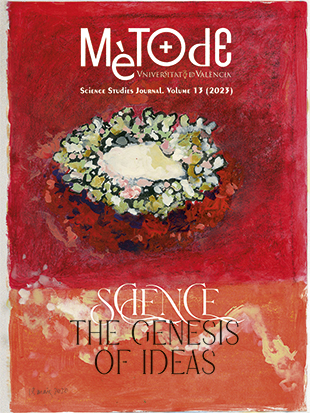La vida adaptada a la precarietat: Ecologia de les zones àrides
DOI:
https://doi.org/10.7203/metode.13.22006Paraules clau:
aridesa, sequeres, biodiversitat, adaptacions, desertificació Resum
Resum
Doctor en Biologia per la Universitat d’Alacant, és catedràtic d’Ecologia en la Universitat Rey Juan Carlos (en excedència) i investigador distingit en la Universitat d’Alacant (Espanya), on dirigeix el Laboratori d’Ecologia de Zones Àrides i Canvi Global. És especialista en l’ecologia de les zones àrides, la desertificació i els impactes del canvi climàtic en aquests ecosistemes.
 Descàrregues
Descàrregues
 Referències
Referències
Cherlet, M., Hutchinson, C., Reynolds, J., Hill, J., Sommer, S., & von Maltitz, G. (Eds.). (2018). World Atlas of Desertification. Publication Office of the European Union. https://doi.org/10.2760/9205
D’Odorico, P., Bhattachan, A., Davis, K., Ravi, S., & Runyan, C. (2013). Global desertification: Drivers and feedbacks. Advances in Water Resources, 51, 326–344. https://doi.org/10.1016/j.advwatres.2012.01.013
FAO. (2011). Highlands and drylands. (N. Berrahmouni, R. Romeo, D. McGuire, S. Zelaya, D. Maselli, & T. Kohler, Eds.). Food and Agriculture Organization of the United Nations.
FAO. (2019). Trees, forests and land use in drylands: The first global assessment. Food and Agriculture Organization of the United Nations. https://www.fao.org/3/ca7148en/ca7148en.pdf
FAO. (2021). The state of the world’s land and water resources for food and agriculture. Systems at breaking point. Synthesis report. Food and Agriculture Organization of the United Nations. https://doi.org/10.4060/cb7654en
Hewitt, K. (1997). Regions at risk. A geographical introduction to disasters. England. Longman.
Le Houérou, H. N. (1984). Rain use efficiency: A unifying concept in arid-land ecology. Journal of Arid Environments, 7, 213–47.
Lucatello, S., & Huber-Sannwald, E. (2020). Sustainable Development Goals and drylands: Addressing the interconnection. In S. Lucatello, E. Huber-Sannwald, I. Espejel, & N. Martinez-Taguena (Eds.), Stewardship of future drylands and climate change in the Global South (pp. 27–40). Springer.
Maestre, F. T. (2012). Plant species richness and ecosystem multifunctionality in global drylands. Science, 214, 214–218. https://doi.org/10.1126/science.1215442
Maestre, F. T., Benito, B. M., Berdugo, M., Concostrina-Zubiri, L., Delgado-Baquerizo, M., Eldridge, D. J., Guirado, E., Gross, N., Kefi, S., Le Bagousse-Pinguet, Y., Ochoa-Hueso, R., & Soliveres, S. (2021). Biogeography of global drylands. New Phytologist, 231(2), 540–558. https://doi.org/10.1111/nph.17395
Maestre, F. T., Salguero-Gomez, R., & Quero, J. L. (2012). It is getting hotter in here: Determining and projecting the impacts of global environmental change on drylands. Philosophical Transactions of the Royal Society B: Biological Sciences, 367(1606), 3062–3075. https://doi.org/10.1098/rstb.2011.0323
Martinez-Valderrama, J. (2016). Los desiertos y la desertificación. Ediciones Catarata.
Millenium Ecosystem Assessment (MEA). (2005). Drylands. In R. Hassan, R. Scholes, & N. Ash (Eds.), Ecosystems and human well being: Scenarios (pp. 623–662). Island Press.
Mirzabaev, A., Wu, J., Evans, J., Garcia-Oliva, F., Hussein, I. A. G., Iqbal, M. M., Kimutai, J., Knowles, T., Meza, F., Nedjraoui, D., Tena, F., Turkeş, M., Vazquez, R. J., & Weltz, M. (2019). Desertification. In J. M. P. R. Shukla, J. Skea, E. Calvo Buendia, V. Masson-Delmotte, H.-O. Portner, D. C. Roberts, P. Zhai, R. Slade, S. Connors, R. van Diemen, M. Ferrat, E. Haughey, S. Luz, S. Neogi, M. Pathak, J. Petzold, J. Portugal Pereira, P. Vyas, E. Huntley, ... J. Malley (Eds.), Climate change and land: An IPCC special report on climate change, desertification, land degradation, sustainable land management, food security, and greenhouse gas fluxes in terrestrial ecosystems (pp. 249–343). UNEP. https://www.ipcc.ch/srccl/chapter/chapter-3/
Plaza, C., Zaccone, C., Sawicka, K., Mendez, A. M., Tarquis, A., Gasco, G., Heuvelink, G. B., Schuur, E. A. G., & Maestre, F. T. (2018). Soil resources and element stocks in drylands to face global issues. Scientific Reports, 8(1), 1–8. https://doi.org/10.1038/s41598-018-32229-0
Reynolds, J. F., Kemp, P. R., Ogle, K., & Fernandez, R. J. (2004). Modifying the –pulse-reserve– paradigm for deserts of North America: Precipitation pulses, soil water, and plant responses. Oecologia, 141, 194–210. https://doi.org/10.1007/s00442-004-1524-4
UN. (2015, 25 September). General Assembly Resolution 70/1, Transforming Our World: The 2030 Agenda for Sustainable Development, A/RES/70/1. http://undocs.org/A/RES/70/1
UNCCD. (2017). The global land outlook (1st ed.). United Nations Convention to Combat Desertification.
UNEP-WCMC. (2007). A spatial analysis approach to the global delineation of dryland areas of relevance to the CBD Programme of Work on Dry and Subhumid Lands. Dataset based on spatial analysis between WWF terrestrial ecoregions (WWF-US, 2004) and aridity zones (CRU/UEA; UNEPGRID, 1991). Dataset checked and refined to remove many gaps, overlaps and slivers (July 2014).
Vanham, D., Alfieri, L., Florke, M., Grimaldi, S., Lorini, V., Roo, A. De, & Feyen, L. (2021). The number of people exposed to water stress in relation to how much water is reserved for the environment: A global modelling study. Lancet Planet Health, 5, 766–774. https://doi.org/10.1016/S2542-5196(21)00234-5
Descàrregues
Publicades
Com citar
-
Resum1809
-
PDF 618
Número
Secció
Llicència
![]()
Tots els documents inclosos en OJS són d'accés lliure i propietat dels seus autors.
Els autors que publiquen en aquesta revista estan d'acord amb els següents termes:
- Els autors conserven els drets d'autor i garanteixen a la revista el dret a la primera publicació del treball, llicenciat baix una llicència de Reconeixement-NoComercial-SenseObraDerivada 4.0 Internacional de Creative Commons, que permet a altres compartir el treball amb un reconeixement de l'autoria del treball i citant la publicació inicial en aquesta revista.
- Es permet i s'anima els autors a difondre la versió definitiva dels seus treballs electrònicament a través de pàgines personals i institucionals (repositoris institucionals, pàgines web personals o perfils a xarxes professionals o acadèmiques) una vegada publicat el treball.





